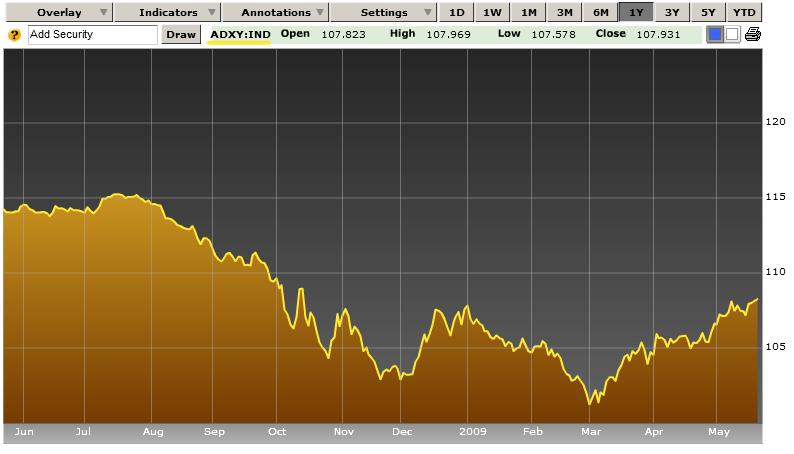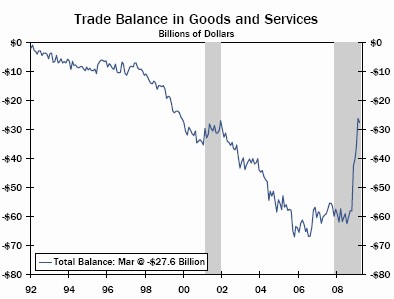Everyone has heard the cliche that currency markets are the most viable because there’s no such thing as a bear market; a decline in one currency must necessarily be offset by a rise in at least one other currency. This truism has taken on a new significance in the context of the credit crisis, where sell-offs in virtually every other asset class has sent investors scrambling in search of yield. Despite even the current rally in stocks and commodities, forex volume is surging.
Aggregate forex data is essentially nonexistent, and also unreliable since its based on surveys rather than actual numbers. But anecdotal evidence from the major players in forex suggests that interest has exploded. “Volumes on dbFX, the online retail trading platform from Deutsche Bank, increased 37% in the first quarter of 2009 from the same period a year earlier. ….particularly impressive given sharp volume gains in October, at the height of market fears, when retail investor interest spiked due to intensified volatility.”
Ironically, the increase in retail forex trading has coincided with a relative decline in institutional trading, as banks collectively make an effort to get back to their roots of providing financial services and move away from position-taking. “The crisis has also led many houses to disable algorithmic trading models, which had been big volume drivers.”
Japanese retirees were probably the first, or at least the most famous, mainstream group to trade in the currency markets. They famously used the carry trade to bet against the Yen. When this strategy imploded, it was left to investors from other countries to pick up the slack. “Contracts for Difference (CFD) providers [in Australia] are noticing the shift. Many newcomers to CFDs, they say, are overlooking margin trading over shares for the prospect of trading currencies instead.”
Equity traders are also starting to pay attention to forex. The Dollar’s recent volatility has effected significant changes in corporate profitability. For companies that are export-oriented and/or are net buyers of commodities, the strong Dollar has provided a windfall. One analyst added, “Travel and leisure companies will also benefit from the weak dollar as this means that travel is now more affordable for foreigners.” If and when the Dollar recovers, companies that do business overseas are poised to reap the benefit.
For novice forex traders, the most important decision involves choosing a trading approach; “The type of forex trader you are will determine how frequently you trade, the type of currency pairs you choose to trade, the charts you use, and even the strategies that you employ to make money on the markets.” Generally speaking, day traders churn their portfolios daily, and hence stick to the most volatile currency pairs. Swing traders typically hold positions from one day to several weeks, and rely on a combination of technical and fundamental analysis.
Position traders, in contrast, don’t worry about “short-term market movements like the day trader or swing trader, but about long-term trends spanning weeks or months.” These types of traders, as well as those who aren’t ready to take the plunge directly into forex, should also consider currency ETFs, currency options, and currency CDs. As one instructor summarized, “The upside to these is that you can get started in currencies right through the same stock brokerage account that you would buy IBM, GE or Google.”
Today, the Bank of Canada followed up on an earlier promise by formally clarifying its position on quantitative easing. Suffice to say that the markets breathed a huge sigh of relief when it was revealed that the BOC was not committing itself to such a program. ” ‘The market has always had great trepidation about the idea of printing money…As the Bank of Canada has pushed back at that notion, the Canadian dollar is having a little party of its own,’ ” quipped one analyst.
In other words, the BOC would like to avoid following in the footsteps of its counterparts in the US, UK, Japan, and perhaps the EU, by pumping newly-minted money directly into credit and government bind markets. At the same time, the Bank admitted that a rapid deterioration in the Canadian economy would certainly prompt it to reconsider. Governor Mark Carney et al have approached the subject of quantitative easing coyly. On the one hand, today’s report (as well as the BOC website) contain detailed explanations of what quantitative easing would hypothetically entail. On the other hand, they insist that such a scenario does not fit with their economic projections, and hence remains unlikely. “The need to do extraordinary easing is a ‘big if,’ ” in the words of Governor Carney.
This is largely consistent with analysts’ expectations, one of whom had predicted that “it’s also quite possible the bank could simply lay out a framework on Thursday and not take any action at all.” Even ignoring the inflationary implications of quantitative easing, it’s not clear whether such a policy could even be effective. “The corporate bond market is reviving, with spreads narrowing and issuance levels improving, raising the question of whether central bank involvement is necessary or appropriate in a market that seems to be healing itself.” Granted, most investors are now wearing their rose-tinted glasses, but the data speaks for itself.
The BOC’s estimation that it can avoid quantitative easing is somewhat dubious, since it is predicated on overly optimistic economic forecasts, as well as because it has already exhausted the primary tool in its monetary arsenal. Earlier this week, it lowered interested rates to a record low of .25%, capping a 16-month period of easing, during which it slashed rates by 4.25%. By the Bank’s own reckoning, interest rates will remain low until mid-2010, as inflation is now comfortably within the target range of 1-3%.




 Given the abysmal economic situation, it is no surprise that inflation has moderated. Commodity prices are well below the record highs of 2008. Aggregate demand, and GDP by extension, are retreating in kind. According to one economist, ” ‘When you do that math, no matter how optimistic you are, you are talking about a time frame of years before things like the unemployment rate (are) back down to historically normal levels.’ ”
Given the abysmal economic situation, it is no surprise that inflation has moderated. Commodity prices are well below the record highs of 2008. Aggregate demand, and GDP by extension, are retreating in kind. According to one economist, ” ‘When you do that math, no matter how optimistic you are, you are talking about a time frame of years before things like the unemployment rate (are) back down to historically normal levels.’ ”
Still, traders remain bullish on the Loonie. “Since March 9, the loonie has climbed 6.2 percent…The loonie will appreciate to C$1.19 by the end of March next year, according to the median forecast of 38 economists and analysts in a Bloomberg survey.” As the Forex Blog reported in yesterday’s post, the carry trade has returned, which is good news for commodity currencies, low interest rates are not. Meanwhile, low interest rates could stimulate corporate borrowing and home buying. Given the Central Bank’s reluctance to print money, the economic recovery would even unfold without the drag of inflation. Maybe the excitement is justified…
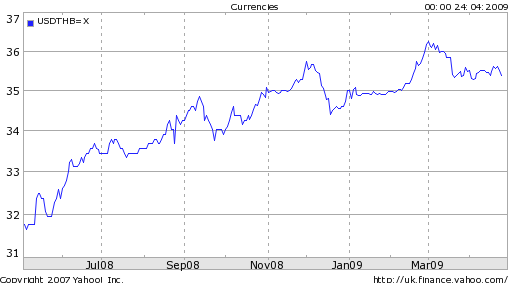
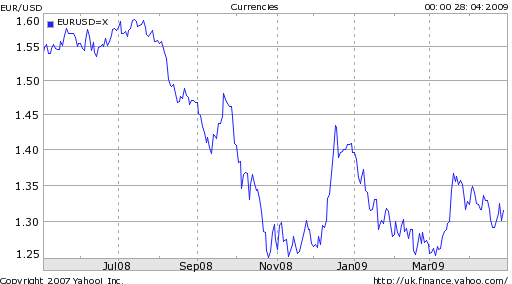
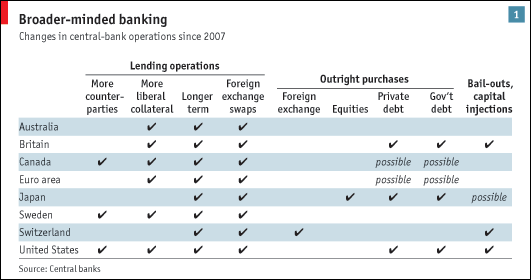
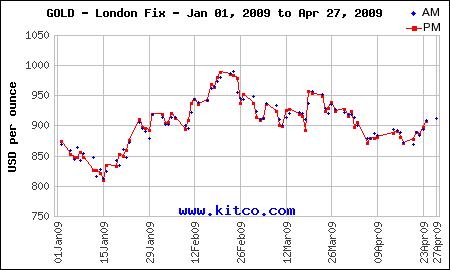
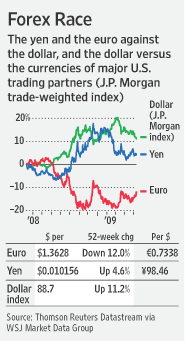 In other words, investors are allocating capital on the basis of risk, rather than in accordance with (economic) fundamentals. For example, “ICE’s Dollar Index and crude oil have a
In other words, investors are allocating capital on the basis of risk, rather than in accordance with (economic) fundamentals. For example, “ICE’s Dollar Index and crude oil have a 